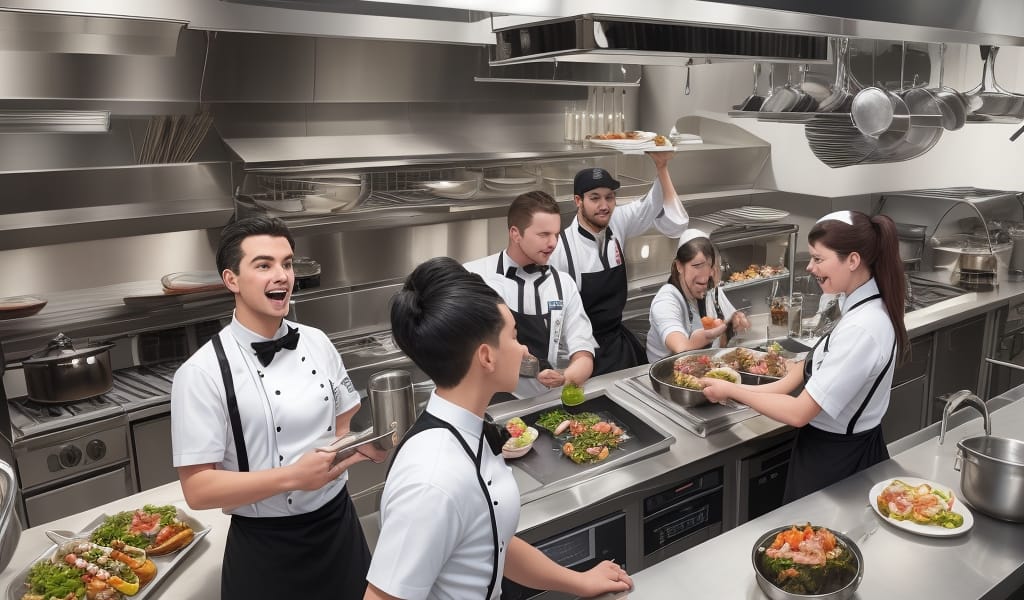Key Takeaways:
- Implement a comprehensive shift handover protocol to ensure seamless shift changes and uninterrupted operational flow
- Train staff on the importance of clear, concise communication during shift changeovers to minimize misunderstandings and errors
- Develop a standardized checklist for each shift to ensure all duties are completed and important information is passed on
- Encourage team building activities to foster a cooperative environment, making shift transitions smoother
- Monitor and regularly review shift change procedures to identify any issues and make necessary improvements.
The Secrets Behind a Flawless Shift Changeover
Ensure Smooth Transitions Between Restaurant Shifts
Shift changeovers represent a critical juncture in every restaurant’s daily operations, significantly impacting customer experience, staff morale, and overall efficiency. Poorly managed transitions can lead to communication breakdowns, operational disruptions, and decreased customer satisfaction. Conversely, a well-executed shift handover ensures seamless continuity, keeping your restaurant running smoothly and your team productive and engaged.
In this comprehensive guide, we’ll explore proven strategies and practical tips for mastering the art of efficient shift management. From clear communication protocols to structured staff handovers, these insights will help you optimize your operational flow and enhance your restaurant’s performance.
Why Effective Shift Management Matters
At its core, managing shift transitions is about maintaining operational consistency. Restaurants operate in high-pressure environments where minor oversights can quickly escalate into significant issues. Effective shift management ensures that every employee entering a shift is fully informed, prepared, and ready to deliver exceptional service.
Consider the example of a bustling downtown café. During peak hours, every second counts, and delays caused by unclear handovers or communication gaps can rapidly lead to customer dissatisfaction, negative reviews, and loss of repeat business. By prioritizing structured shift handovers, that same café can maintain consistently high standards, ensuring staff feel supported and customers remain satisfied.
Setting the Foundation: Clear Communication Protocols
Establish Standardized Handover Procedures
Consistency is key in ensuring smooth transitions. Establishing standardized procedures provides your team with clear expectations for every shift changeover. Standardized protocols should include:
- A scheduled briefing time before each shift starts
- A designated handover location within the restaurant
- Required documentation, such as shift logs or daily checklists
- Clearly defined roles and responsibilities during the handover
For example, a popular chain restaurant implemented a straightforward five-minute briefing template, outlining customer feedback, menu updates, and stock alerts. This reduced confusion and ensured that all shifts began with accurate and relevant information.
Encourage Open and Transparent Communication
Creating an environment where staff feel comfortable sharing concerns or issues is vital. Encourage team members to openly discuss anything affecting their shift, from equipment malfunctions to challenging customer interactions.
One effective approach is the "open-door policy," where managers remain accessible and attentive to staff feedback during shift transitions. This practice fosters a culture of transparency and helps quickly address potential problems before they escalate.
Developing Comprehensive Shift Reports
Implement Detailed Shift Logs
Shift logs are invaluable tools in operational flow management, providing a written record of essential details for incoming staff. Effective shift logs typically include:
- Customer complaints or special requests
- Inventory shortages or excesses
- Maintenance issues or equipment malfunctions
- Staff attendance notes or performance observations
For instance, a high-volume steakhouse restaurant implemented digital shift logs accessible via tablets. Staff recorded information throughout their shifts, allowing incoming employees to review critical updates instantly upon arrival.
Use Checklists for Consistency
Checklists provide clarity and ensure nothing is overlooked during shift transitions. Tailored checklists guide employees through pre- and post-shift responsibilities, such as:
- Verifying cleanliness and setup of dining areas
- Checking stock levels of essential supplies
- Confirming reservation statuses and special accommodations
- Ensuring cash registers and point-of-sale systems are balanced and functional
A family-owned Italian restaurant improved its operational flow significantly by introducing simple end-of-shift checklists, reducing mistakes, and ensuring smoother handovers.
Training Staff for Effective Shift Handovers
Conduct Regular Staff Training Sessions
Shift management skills are not innate; they require training and reinforcement. Regular training sessions can help staff understand the importance of proper shift handovers and equip them with the necessary skills to execute them effectively.
Training sessions might cover topics such as clear communication techniques, conflict resolution, time management, and emergency procedures. A mid-sized restaurant group invested in monthly training workshops that improved staff confidence and dramatically reduced shift changeover errors.
Assign Mentors to New Employees
Pairing new hires with experienced employees during initial shifts provides hands-on training and practical insights into effective shift management. This mentorship approach helps new staff quickly adapt to your restaurant’s unique operational flow and culture.
For example, a successful seafood restaurant assigns seasoned servers to mentor new hires for their first two weeks. This mentorship ensures that new employees understand expectations clearly and can manage shift transitions independently in a shorter timeframe.
Utilizing Technology to Enhance Operational Flow
Leverage Digital Scheduling Tools
Digital scheduling platforms streamline shift management by automating schedules, sending real-time updates, and facilitating clear communication between staff and management. These platforms allow managers to monitor scheduling coverage, minimize staffing gaps, and quickly adjust shifts as needed.
For instance, a popular urban restaurant adopted a digital scheduling app, significantly reducing shift conflicts, improving communication, and allowing staff to easily swap or pick up shifts with managerial oversight.
Use Messaging Apps for Quick Updates
Instant messaging apps provide a fast and effective way to communicate crucial information during shift handovers. Staff can quickly inform incoming shifts about last-minute reservations, special menu items, or unexpected operational issues.
A casual dining restaurant group successfully implemented team communication via messaging apps, improving responsiveness and ensuring critical information reached all relevant staff members immediately.
Building a Positive Team Culture
Recognize and Reward Effective Shift Management
Positive reinforcement motivates staff to prioritize smooth shift handovers. Acknowledging and rewarding employees who consistently execute successful transitions encourages others to follow suit.
A café chain introduced monthly recognition awards for teams demonstrating exceptional shift management practices, resulting in higher staff motivation and significantly improved operational consistency across locations.
Promote Team Collaboration and Support
Fostering a collaborative environment encourages employees to support each other during transitions. Encourage teamwork by clearly communicating shared goals, reinforcing mutual accountability, and emphasizing the collective responsibility for smooth operational flow.
A downtown bistro regularly hosts team-building activities and group meetings, fostering strong connections among staff and significantly improving communication and collaboration during shift changeovers.
Conclusion
Effective shift management is essential for maintaining operational continuity, enhancing customer satisfaction, and ensuring employee morale. By establishing clear communication protocols, leveraging comprehensive reports and checklists, investing in staff training, utilizing technology, and cultivating a positive team culture, restaurant owners and managers can master the art of flawless shift handovers.
Every restaurant, regardless of size or concept, can benefit from implementing these practical strategies. With consistent effort, clear processes, and a commitment to continuous improvement, your restaurant can achieve seamless operational flow and deliver exceptional experiences to both your customers and your team.






Comments
Be the first to comment on this article.